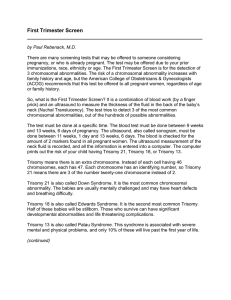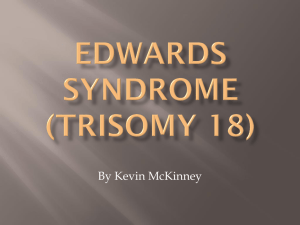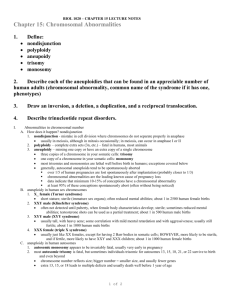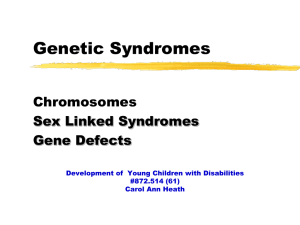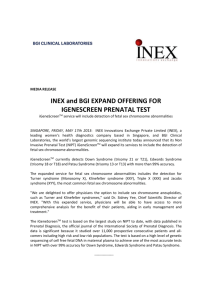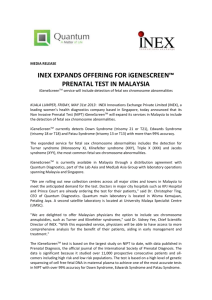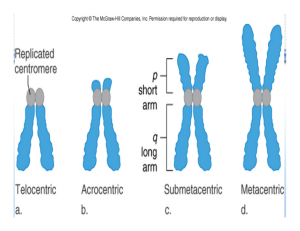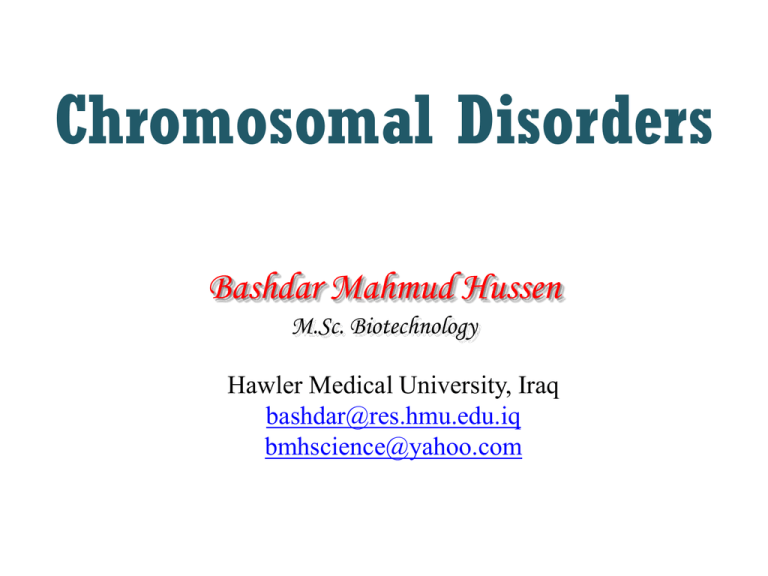
Chromosomal Disorders
Bashdar Mahmud Hussen
M.Sc. Biotechnology
Hawler Medical University, Iraq
bashdar@res.hmu.edu.iq
bmhscience@yahoo.com
Genetic diseases
traditionally - 3 types of diseases
1. genetically determined
2. environmentally determined
3. 1. + 2.
about 50% of spontaneous abortuses have chromosomal
aberration
• hereditary = derived from parents
• familial = transmitted in the gametes through
generations
• congenital = present at birth (not always genetically
determined
Numerical abnormalities
•
•
•
•
•
euploidy - normal 46 (2n)
polyploidy (3n or 4n) - spontaneous abortion
Aneuploidy (whole chr. Missing or extra
trisomy (2n+1) - 47 - compatible with life
monosomy (2n-1) - autosomal - incompatible
with life
• - sex chromosomal - compatible with life
Numerical Abnormalities
– Trisomy 21 (Down syndrome)
– Trisomy 18
– Trisomy 13
– Klinefelter Syndrome
– Turner Syndrome
– Triple X Syndrome
Most common chromosome abnormalities in aborted fetuses is:
Turner syndrome (45,X)
triploidy
trisomy 16
1. No. of genes on
chromosome 21
2. Mosaic Down
syndrome
3. Causes of trisomy
4. Maternal age
Less frequent disorders
• Trisomy 18 (Edwards syndrome) 1:6000
• 95% (extra number), 5% (translocation)
• 90% of infants
die
• Trisomy 13 (Patau syndrome) 1:10000
• They have cleft lip and palates, extra fingers and
toes, malformed and rotated internal organs
Klinefelter Syndrome
•
•
•
•
•
Found only in males (47, XXY most common)
I in 500 males
Nondisjunction of XX homologues
Sterility
Testicular atrophy
Turner Syndrome
• Found in women with unmistakably
female appearance
– Absence of ovaries (gonadal dysgenesis)
– Usually (45, X) missing one X chromosome
1. X-Chromosome Monosomy
2. X-Chromosome Mosaicism
3. X-Chromosome Defects ( small or large deletion)
Triple X syndrome
•
•
•
•
1 in 1,000 girls are born with Triple X syndrome
Menstrual irregularity
Delayed speech & language skill
A mosaic form also occurs where only a
percentage of body cell contain XXX
• not inherited
Prenatal diagnostics
• amniocentesis - analysis of amniotic fluid
• cytogenetic analysis (karyotype)
• analysis of various specific genes (PCR)
Structural Abnormalities
• May involve one or more chromosomes
• Usually result from chromosome breakage
• The effects of structural changes depend on their size &
location
loss of chromosomal material is more dangerous than
gain
abnormalities of sex chromosomes are better tolerated
than autosomal, abnormalities of sex chromosomes
sometimes symptomatic in adult age (e.g. infertility)
partial monosomy
1. proximal deletion (near to centromer)
2. interstitial deletion
3. subtelomeric deletion
It occurs during meiosis between
misaligned homologous chromosomes
(unequal crossing-over)
Duplications of oncogenes
Non Robertsonian translocation
or
Robertsonian translocation
fertility problems.
two identical arms
causes Turner syndrome
Chromosome Mutation
Animation


